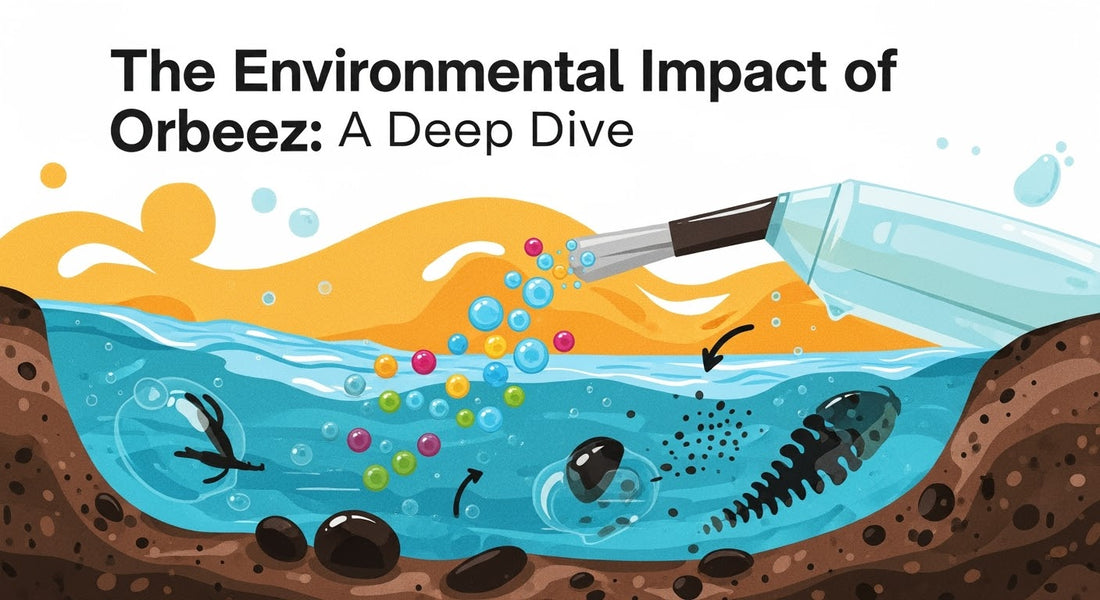
Are Orbeez Biodegradable?
Share
Orbeez—those squishy, color-changing water beads—have become a household favorite for sensory play, home decor, and even gardening. But as eco-consciousness grows, a common question arises: Are Orbeez biodegradable? The answer isn’t a simple “yes” or “no”—it depends on their composition, disposal method, and environmental conditions. This guide dives into the science behind Orbeez’s biodegradability, how long they take to break down, and what this means for your eco-friendly routine.
First: What Are Orbeez Made Of?
To understand if Orbeez are biodegradable, we need to start with their core ingredient: superabsorbent polymer (SAP). SAP is a synthetic material designed to absorb and retain massive amounts of water—up to 300 times its weight. Most commercial Orbeez use polyacrylamide, a type of SAP commonly found in diapers, agricultural water retention products, and hygiene items.
Polyacrylamide is a man-made polymer, which means it’s not naturally occurring. Unlike organic materials like wood or paper, synthetic polymers are engineered to resist breakdown—a trait that makes Orbeez durable and long-lasting for play, but problematic for the environment when discarded.
So, Are Orbeez Biodegradable? The Short Answer
Traditional Orbeez (made from synthetic polyacrylamide) are not fully biodegradable in the short term. They do not break down quickly in natural environments like soil, water, or landfills. However, they are hydrolyzable—meaning they can break down into smaller molecules over time when exposed to water, heat, and microorganisms. But this process takes far longer than most people realize.
How Long Do Orbeez Take to Decompose?
The decomposition time for Orbeez varies based on environmental conditions, but here’s what research and waste management experts say:
-
In Landfills: Landfills are anaerobic (low-oxygen) environments, which slow decomposition dramatically. Orbeez can take 2–10 years to break down in landfills. During this time, they trap moisture, contributing to mold growth and methane emissions.
-
In Soil: In aerobic (oxygen-rich) soil with microorganisms, Orbeez break down faster—but still not quickly. Studies show they take 6–12 months to decompose in garden soil, especially if crushed into smaller pieces. However, uncrushed beads can persist for years.
-
In Water: Orbeez in oceans, lakes, or rivers decompose even more slowly. The cold, low-oxygen conditions and lack of specific microorganisms mean they can last 5+ years, posing a risk to marine life that may ingest them.
Compare this to fully biodegradable materials like banana peels (2–5 weeks) or paper (2–5 months), and it’s clear: Orbeez are not a “disposable” eco-friendly option.
Why Orbeez’s Biodegradability Matters for the Environment
The slow decomposition of Orbeez creates several environmental issues:
-
Marine Life Threat: Orbeez’s small size and bright colors make them look like food to fish, birds, and turtles. When ingested, they expand in the digestive systems, causing blockages, malnutrition, and death.
-
Soil Disruption: Dumping Orbeez in soil can alter moisture levels and create air pockets, suffocating plant roots and disrupting ecosystem balance.
-
Waste Accumulation: With millions of households using Orbeez annually, their slow decomposition adds to the growing problem of plastic and synthetic waste in landfills.
Eco-Friendly Alternatives to Traditional Orbeez
If you want the sensory fun of water beads without the environmental impact, opt for these biodegradable alternatives:
-
Starch-Based Water Beads: Made from cornstarch or potato starch, these beads are fully biodegradable. They decompose in soil in 4–6 weeks and are non-toxic if ingested (though still not meant to be eaten). Brands like “Eco Beads” or “Biodegradable Water Beads” offer these options.
-
Natural Sensory Materials: Swap Orbeez for organic alternatives like dried rice, beans, lentils, or even crushed eggshells. These materials are compostable, affordable, and safe for kids and pets.
-
Reusable Silicone Beads: For long-term play, silicone beads are a great option. They’re non-toxic, easy to clean, and can be reused indefinitely—no disposal needed.
How to Dispose of Non-Biodegradable Orbeez Responsibly
If you already have traditional Orbeez, dispose of them in ways that minimize environmental harm:
-
Dry and Crush: Let Orbeez air-dry completely (1–3 days) until they shrink to tiny pellets. Crush them into smaller pieces to speed up decomposition.
-
Compost Sparingly: Add crushed Orbeez to a hot compost pile (130–160°F) with other organic materials. Avoid cold compost bins, where they’ll break down too slowly.
-
Repurpose or Donate: Use dried Orbeez as garden mulch (to retain moisture) or donate clean beads to schools or daycares for sensory play. This keeps them out of landfills.
-
Avoid Drains and Waterways: Never flush Orbeez or pour them down drains—they clog pipes and end up in waterways. Always dry and dispose of them in sealed trash bags if composting/donating isn’t an option.
Common Myths About Orbeez Biodegradability
Let’s debunk some widespread misconceptions:
-
Myth: “Orbeez are biodegradable because they’re ‘just water beads.’” Fact: Their synthetic SAP composition means they’re not fully biodegradable in the short term.
-
Myth: “Flushing Orbeez is fine because they’ll break down in sewage.” Fact: Sewage treatment plants can’t filter Orbeez, so they end up in waterways where they harm marine life.
-
Myth: “All water beads are the same.” Fact: Starch-based beads are biodegradable, but traditional Orbeez are not.
Conclusion
To answer the question “Are Orbeez biodegradable?”: Traditional Orbeez made from synthetic polyacrylamide are not fully biodegradable in a reasonable timeframe. They take years to break down in landfills, soil, and water, posing risks to the environment and wildlife. However, by choosing biodegradable alternatives, repurposing Orbeez, or disposing of them responsibly (drying, crushing, composting), you can minimize their impact. The key takeaway? Enjoy the sensory fun of water beads, but make informed choices that prioritize the planet. Whether you switch to starch-based beads or reuse traditional Orbeez, every small step helps create a more sustainable future.
